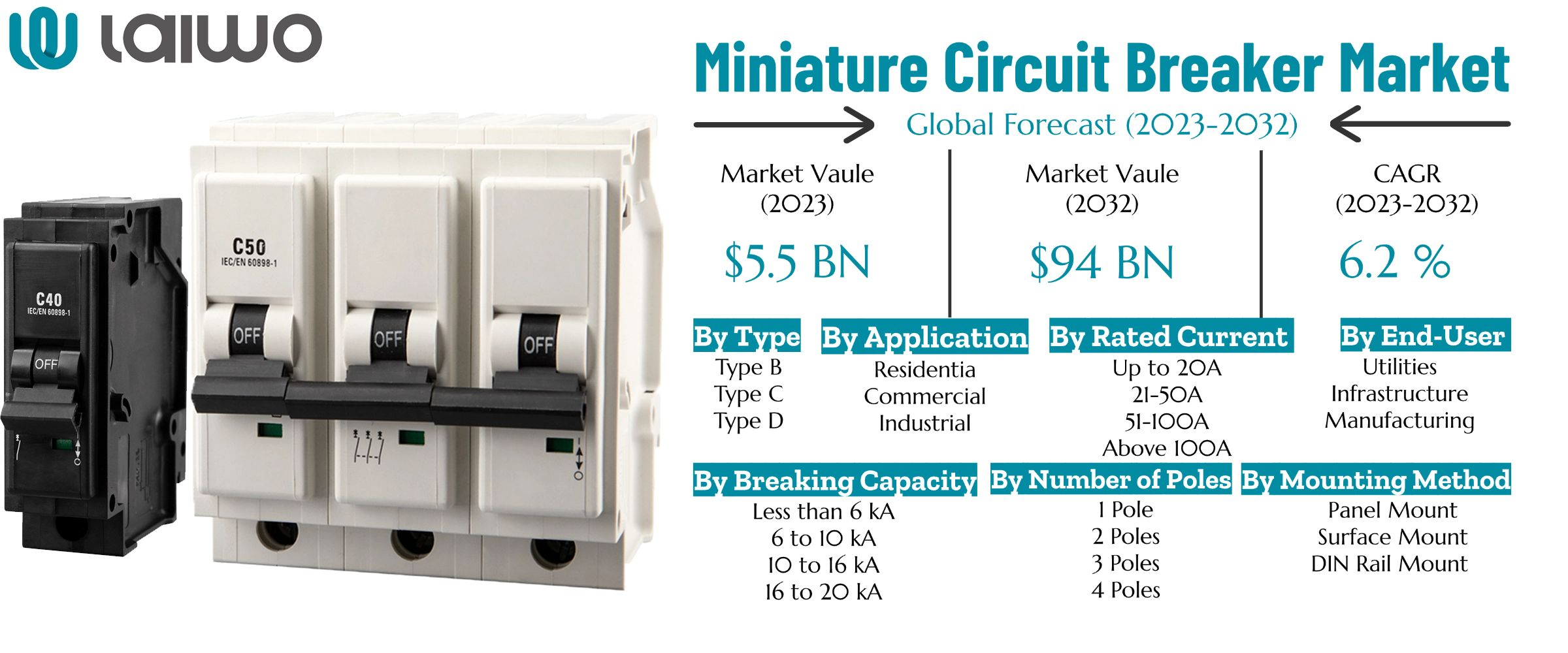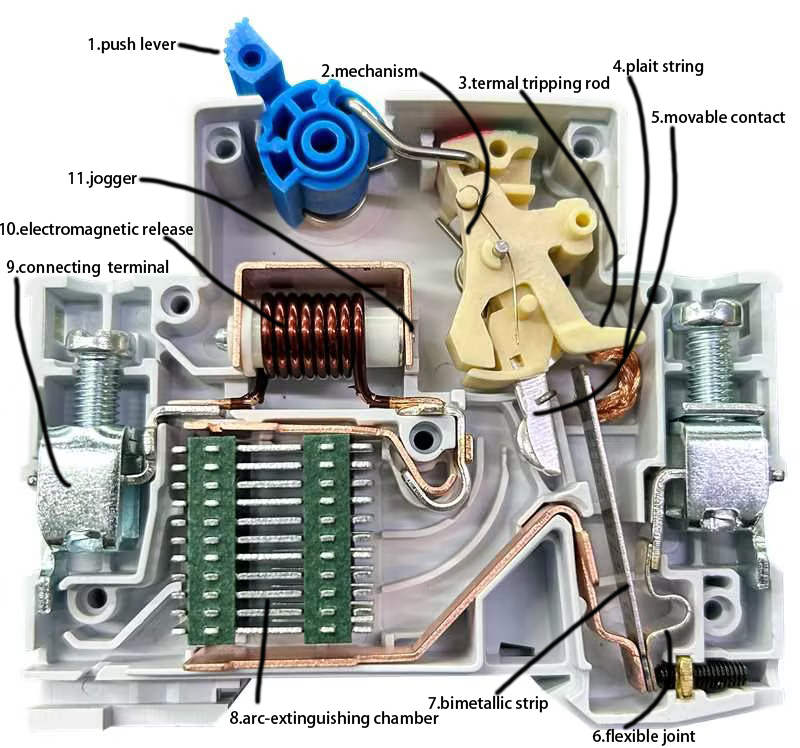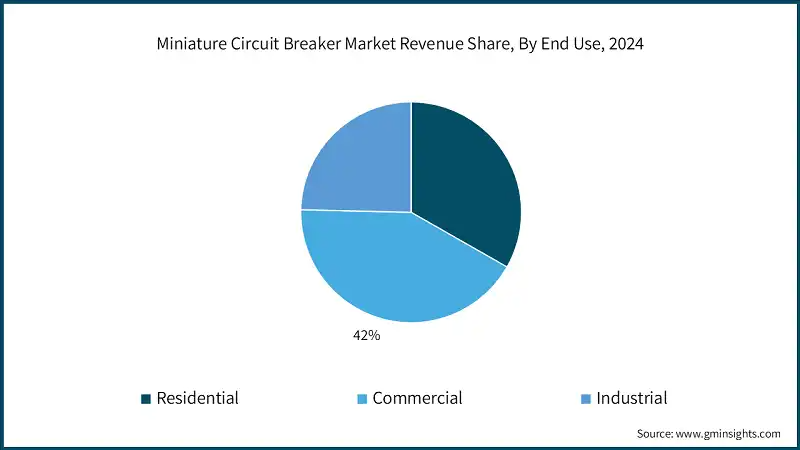

2023 valuation: USD 5.5B
2024 valuation: USD 5.7B
USD 9.4B by 2032 (6.2% CAGR)
USD 14.4B by 2034 (9.2% CAGR, 2025-2034)
USD 18.6B by 2032 (6.3% CAGR)
USD 30.15B by 2034 (3.72% CAGR)
The methodology adopted by the research companies may affect the reported figures
Top 7 players dominate: Hold 40%+ market share (2024).
Growth driven by global infrastructure development and rising electrical safety standards.
Varying forecasts reflect methodological differences across reports.
Unified trend: Strong upward momentum for MCB demand worldwide.

Miniature Circuit Breakers (MCBs) are electrical protection devices that automatically cut off power during overloads or short circuits, preventing equipment damage and electrical fires. Unlike traditional fuses, MCBs are reusable—simply reset post-fault to restore power.

Overcurrent Protection: Safeguards circuits from excessive current flow.
Manual Reset Function: Eliminates replacement costs (vs. single-use fuses).
Critical Safety Role: Reduces fire risks and ensures system reliability.
Residential: Protects homes from wiring faults in lighting/appliance circuits.
Commercial: Ensures safety in offices, malls, and hospitals.
Industrial: Secures machinery and production lines in factories.
As core components of modern electrical systems, MCBs balance safety, cost-efficiency, and convenience. Their global adoption reflects decades of innovation in electrical safety technology.
Click here to download the laiwo mcb catalogue
| Drivers | Key Points |
|---|---|
| Growing Demand for Safe Electrical Systems | Rising reliance on electricity in residential/commercial/industrial sectors increases need for fault protection. |
| Urbanization & Industrialization in Emerging Economies | Construction boom (e.g., $4.2B real estate PE investments in India) and industrial expansion drive infrastructure needs. |
| Stricter Government Safety Regulations | - EU Energy Efficiency Directive mandates MCBs in new constructions. - India’s Ministry of Power sets MCB standards for commercial buildings. |
| Smart Grid & Automation Adoption | Integration with smart meters, home automation, and IoT-enabled systems (e.g., ABB’s IoT MCBs). |
| Renewable Energy Integration | Solar/wind power systems require MCBs for grid safety; boosted by global renewable investments. |
| Technological Advancements | Innovations like Siemens’ solid-state circuit breakers and IoT-enhanced MCBs improve performance. |

Source: www.gminsights.com
Reliable circuit protection is critical across residential, commercial, and industrial sectors due to increasing reliance on electricity.
MCBs prevent electrical faults, reducing risks of fires and equipment damage.
Emerging economies drive construction of urban housing, factories, and infrastructure: Example: India’s real estate sector attracted USD 4.2B in private equity (2023 data).
Global industrial sector growth accelerates demand for robust electrical systems with MCBs.
New buildings and facilities require advanced circuit protection to meet safety standards.
MCBs are integral to power distribution networks in smart cities and industrial hubs.
Strict compliance mandates like the EU Energy Efficiency Directive 2010/31/EU require MCB integration in new constructions (effective 2021).
India’s Ministry of Power enforces current rating standards for MCBs in commercial buildings, boosting adoption.
Smart meter adoption and home automation systems demand high-performance MCBs for safe device connectivity.
Smart grid investments prioritize MCBs that ensure network reliability in interconnected systems.
Global renewable energy adoption (solar/wind) requires safe power distribution systems for homes, businesses, and grids.
MCBs ensure stable energy flow from solar panels/wind turbines to electrical networks, preventing overloads.
Grid modernization investments prioritize MCBs to handle clean energy integration.
|
Miniature circuit breaker(mcb) manufacturer |
Location |
Website |
|
laiwo |
China |
wosomelec.com |
|
ABB |
Switzerland |
global.abb |
|
alfanar Group |
Riyadh |
alfanar.com |
|
Eaton Corporatio |
Ireland |
eaton.com |
|
General Electric |
United States |
ge.com |
|
Ha ger Group |
Germany |
hager.com |
|
HD HYUNDAI ELECTRIC |
South Korea |
hd-hyundaielectric.com |
|
Legrand |
United States |
www.legrand.com |
|
LOVATO ELECTRIC |
United States |
lovatoelectric.com |
|
LS ELECTRIC |
South Korea |
ls-electric.com |
|
Mitsubishi Electric |
Japan |
mitsubishielectric.co.jp |
|
Powell Industries |
United States |
powellind.com |
|
Schneider Electric |
France |
se.com/fr/fr |
|
Sensata Technologies |
United States |
sensata.com |
|
Siemens |
Germany |
siemens.com |
|
Havells |
India |
havells.com |
The global MCB market is characterized by the presence of several major players competing for market share. Some of the leading companies operating in this market include ABB, Schneider Electric, Siemens, Eaton Corporation, Mitsubishi Electric, Legrand, and LS ELECTRIC, which collectively held over 40% of the market share in 2024 . Other significant players include laiwo alfanar Group, General Electric, Hager Group, HD HYUNDAI ELECTRIC, LOVATO ELECTRIC, Powell Industries, Sensata Technologies, WEG, Panasonic, Carling Technologies, and Rockwell Automation
Upfront costs deter adoption in price-sensitive markets (e.g., small-scale residential projects).
Long-term savings from safety/reliability often overshadowed by initial investment barriers.
Top 7 market leaders dominate, creating supply chain risks and pricing inflexibility.
Lack of supplier diversity limits options for high-performance MCBs.
Rapid innovation in smart circuit breakers (e.g., IoT integration) threatens legacy MCB systems.
Upgrading to newer technologies increases operational disruptions and costs.
Manufacturers in emerging economies (e.g., China, Vietnam) undercut prices, pressuring margins.
Forces established players to prioritize cost reduction or premium differentiation.
Strict certifications (e.g., EU/India standards) increase R&D timelines and costs.
Delays in product launches affect market responsiveness.
Copper and plastic price fluctuations disrupt production budgets and MCB pricing stability.
Impacts profitability for manufacturers and purchasing decisions for end-users.
Price wars erode margins; brands rely on product innovation (e.g., eco-friendly designs) to compete.
High marketing costs strain budgets for smaller players.
Fake MCBs compromise electrical safety, damaging trust in certified brands.
Requires aggressive anti-counterfeiting measures and consumer education.
Downturns in construction and industrial sectors reduce MCB orders.
Example: Slowed infrastructure projects during economic recessions.
The global MCB market can be segmented based on several factors, including type, application, rated current, end-user, mounting method, breaking capacity, and the number of poles.
By Type, the market is divided into Type B, Type C, Type D, and Others. Currently, Type C miniature circuit breakers hold the largest market share due to their versatility and widespread use in various applications.
By Application, the market includes Residential, Commercial, Industrial, and Others. MCBs with a rated current of up to 20A are predominantly used in residential applications, where electrical loads are typically low.
By Rated Current, the market is categorized into Up to 20A, 21-50A, 51-100A, and Above 100A. The segment of MCBs rated Up to 20A is mainly used in residential settings. The < 200 A segment is anticipated to experience significant growth, potentially crossing USD 9.5 billion by 2034, driven by extensive adoption in residential apartments, small businesses, and low voltage power distribution networks. The 200 A to 500 A segment is also witnessing considerable growth due to its application in medium industrial and commercial buildings requiring better circuit protection for larger electrical loads. Additionally, the > 500 A rated current segment continues to grow in heavy industry, power distribution systems, and critical infrastructure.
By End-User, the market is segmented into Utilities, Infrastructure, Manufacturing, and Others. Each of these sectors has distinct demands and growth drivers influencing the type and quantity of MCBs required.
By Mounting Method, the market includes Panel Mount, Surface Mount, and DIN Rail Mount. In 2023, the Panel Mount segment held the largest market share and is expected to maintain its dominance throughout the forecast period.
By Breaking Capacity, the market is segmented into 'Less than 6 kA', '6 to 10 kA', '10 to 16 kA', and '16 to 20 kA'. The 'Less than 6 kA' segment is projected to hold the largest market share in 2023, owing to its widespread use in residential and commercial applications.
By Number of Poles, the market is divided into 1 Pole, 2 Poles, 3 Poles, and 4 Poles. The 2 Poles segment held the largest market share in 2023 and is expected to continue dominating, driven by increasing demand in residential and commercial applications. The 1 Pole segment is anticipated to experience significant growth during the forecast period, primarily due to rising demand in industrial applications.

Europe also holds a substantial share of the MCB market, accounting for over 17% in 2024. The growth in the European market is fueled by the increasing adoption of renewable energy sources, the expansion of smart grids, and the implementation of stringent electrical safety policies. Furthermore, ongoing expansion and investment in housing and commercial real estate are contributing to the market's growth in this region.
The Asia Pacific region dominated the broader circuit breaker market in 2023 with a share of 39.22%. While this figure represents the entire circuit breaker market, it indicates the significant presence and potential for MCBs within this rapidly developing region. The rapid urbanization and industrialization occurring in many Asia Pacific economies are boosting construction activities and driving the need for reliable power distribution systems, which in turn increases the demand for MCBs.
South America and the Middle East & Africa (MEA) are expected to experience moderate growth in the miniature circuit breaker market. This growth is primarily due to the increasing demand for electrical components in these regions as their infrastructure develops and electrification expands.
Based on the provided information, a SWOT analysis of the Miniature Circuit Breakers (MCB) market can be outlined as follows 1:
High production efficiency and scalability: Established players in the market benefit from efficient manufacturing processes and the ability to scale production to meet increasing demand.
High reliability and safety: MCBs are known for their reliability in protecting electrical circuits and ensuring safety, making them a trusted component in electrical installations.
Wide range of applications: MCBs are versatile and can be used in various applications across residential, commercial, and industrial sectors.
High cost of installation and maintenance: The initial cost of installing MCBs and potential maintenance expenses can be a barrier for some users.
Limited number of suppliers: While there are several players, the market might be dominated by a few major suppliers, potentially limiting competition in certain segments.
Potential product obsolescence: Rapid advancements in electrical protection technology could lead to the obsolescence of older MCB models.
Growing demand for energy-efficient products: There is an increasing demand for MCBs that contribute to energy efficiency and sustainability.
Growing adoption of renewable energy sources: The shift towards renewable energy requires reliable circuit protection, creating opportunities for MCB manufacturers.
Increasing investment in smart grid technology: The development of smart grids necessitates advanced MCBs that can integrate with these intelligent systems.
Increasing competition from low-cost countries: Manufacturers from countries with lower production costs can offer competitive pricing, posing a threat to established players.
Stringent regulations from governments: Evolving government regulations regarding electrical safety can pose compliance challenges for manufacturers.
Prices fluctuating according to the availability of raw materials: Volatility in the prices of raw materials can impact the profitability of MCB manufacturers.
This analysis provides a snapshot of the internal and external factors influencing the MCB market. The strengths highlight the fundamental advantages of MCBs, while the weaknesses point to areas that need attention. The opportunities indicate potential avenues for growth, and the threats underscore the challenges that market players need to navigate.
Click here to get laiwo's latest special offers and information on laiwo's latest R&D mcb products.
An analysis of the global Miniature Circuit Breakers (MCB) market using Porter's Five Forces framework reveals the following competitive dynamics:
Threat of New Entrants: The threat of new entrants is low. The MCB market is largely dominated by established players, and significant barriers to entry exist. These barriers include the high costs associated with setting up manufacturing facilities, establishing marketing and distribution networks, and investing in research and development. Existing players also have strong global distribution channels, making it difficult for new entrants to compete effectively.
Threat of Substitutes: The threat of substitutes is low. MCBs are essential for electrical protection in virtually all types of electrical applications, and there is no viable alternative that can completely replace their functionality in terms of cost and efficiency. While other circuit protection technologies like fuses or air circuit breakers exist, they do not offer the same combination of cost-effectiveness and efficiency as MCBs for a wide range of applications.
Bargaining Power of Suppliers: The bargaining power of suppliers is relatively low. There are a large number of suppliers in the market offering MCB components at competitive prices. Additionally, suppliers are often willing to customize their products according to buyers' requirements, further reducing their leverage.
Bargaining Power of Buyers: The bargaining power of buyers is high. The market has a large number of buyers seeking MCBs at competitive prices. Buyers can easily switch between different suppliers to find the best product and price, increasing their negotiating power.
Intensity of Rivalry: The intensity of rivalry among existing players is high. The MCB market has a large number of participants who are continuously focusing on product innovation and marketing strategies to gain a competitive advantage. This intense competition leads to ongoing efforts to improve product features, reduce costs, and expand market reach.
This analysis suggests that while the MCB market benefits from low threats of new entrants and substitutes, the high bargaining power of buyers and intense rivalry among existing players create a competitive environment focused on price and innovation.
Looking ahead, several trends are expected to shape the future of the MCB market. The increasing adoption of MCBs in smart homes and buildings, coupled with their integration into IoT and smart grid technologies, will drive demand for more advanced and connected circuit protection solutions. The development of more energy-efficient and sustainable MCB designs will also gain prominence as environmental concerns grow. Developing regions with rapidly expanding electrification infrastructure present significant growth opportunities for MCB manufacturers. Overall, the global MCB market is poised for continued growth, driven by fundamental needs for electrical safety and the ongoing evolution of electrical infrastructure worldwide. Market players who can effectively address the challenges and capitalize on the emerging trends are likely to achieve sustained success in this dynamic and essential sector.
Miniature Circuit Breakers (MCB) Market Research Report 2032
Miniature Circuit Breaker Market Share, Outlook 2025-2034
Miniature Circuit Breaker Market Size
Circuit Breaker Market Size, Share, Industry Growth 2032 - Fortune Business Insights
Circuit Breaker Market Size, Share, Industry Analysis [2023-2032] - MarketsandMarkets
Miniature Circuit Breakers Market Research Report 2032 - Dataintelo
Circuit Breakers Market Size to Worth USD 25.26 billion by 2033, at a CAGR of 6
INQUIRY NOW